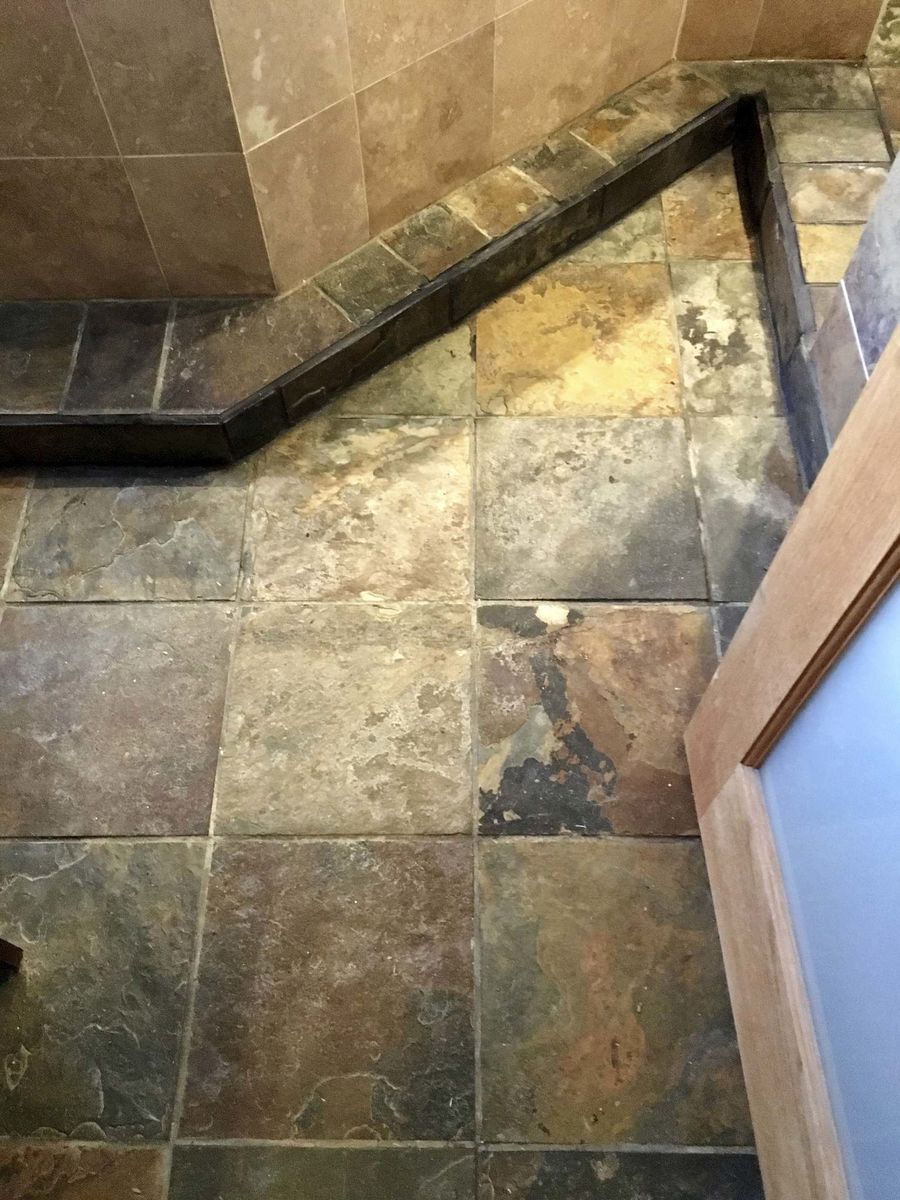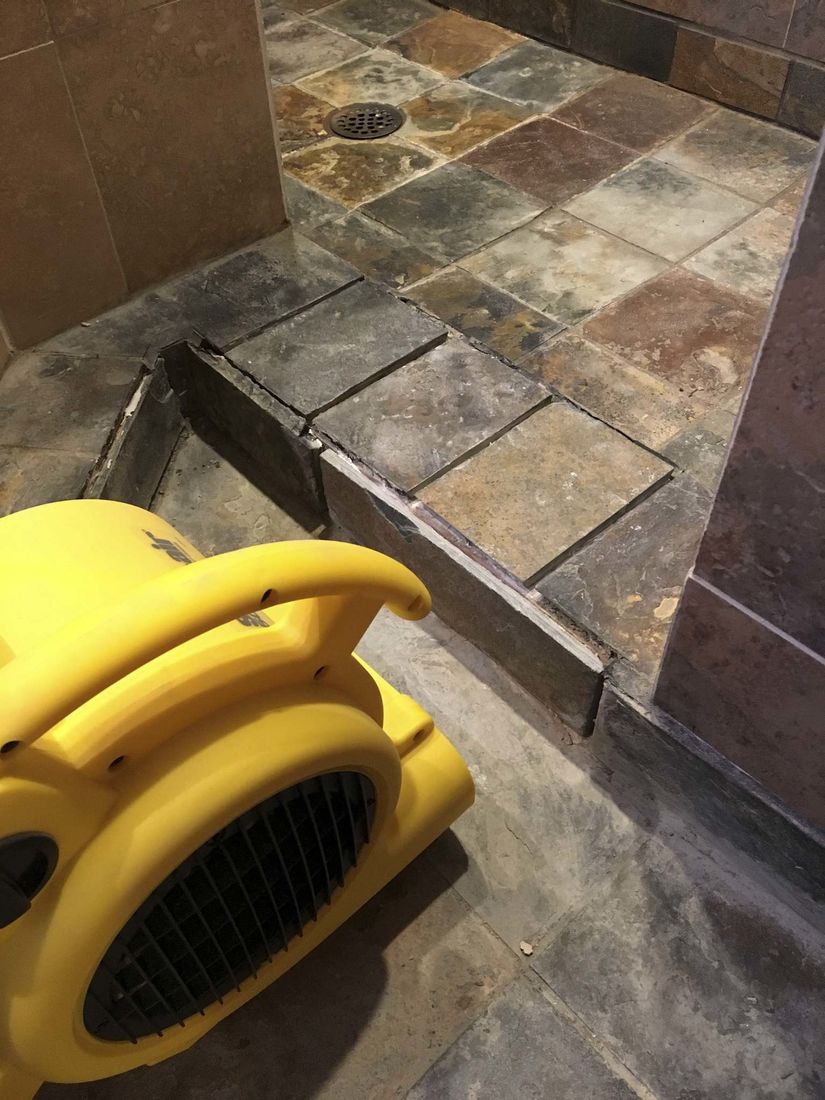
Photos by Marc LaBossiere
After removing all the loose slate tiles, the area was first dried before each tile was reset into its original position — a resin grout was used to fill the empty grout lines.

A fan blower expedites the drying time of the thinset used to secure the slate tiles back into their original positions.
Over time, tiles of a well-travelled floor can slowly begin to loosen, providing a slight shifting sensation beneath your feet. When not addressed in a timely fashion, this motion can cause tiles to crack, resulting in much bigger problems.
It’s always best to tackle loose tiles soon after noticing.
When installing tile, buying 10 per cent more than required for any given tiling surface is the rule of thumb. Having extra tile allows for partial tile cuts, cutting errors and, eventually, the potential for the replacement of broken tiles.
Before starting my big studio renovation and second-floor bathroom expansion in late 2005, the hunt for flooring tile had been underway for quite some time. The rustic esthetics of my house dictated a necessity for an earthy flooring tile. My search ended when I came across several pallets of natural slate tile at Home Depot, 12-by-12-inch slate tiles cut to between a quarter and three-eighths of an inch thick. The slate was perfect, and an entire pallet of tile was purchased so it could be installed throughout the house (far exceeding the 10 per cent rule).
The main entrance foyer and a few inlays within the hardwood floor at the other front door and in the kitchen, as well as the main-floor bathroom all received the slate-tile treatment. Once the studio addition and bathroom expansion were nearly completed, the slate tile was also installed in the hallway leading to the studio and the existing second-floor bathroom into the expansion. The same slate was cut to four-inch-high, 12-inch-long sections for use as baseboards, and six-by-six-inch square tiles were set along the shower-stall base. Other than being resealed a couple of times since the initial install, this natural slate had fared quite well for 14 years — until last week.
It had become apparent that a few of the corner grout lines along the step to the jacuzzi tub and shower-base edge were showing some gapping, which unfortunately allowed water to enter in and behind the slate. This in turn had caused the tile adhesive to weaken and eventually fail. As such, a few of the tiles were easy to move slightly. Knowing this issue would only get worse, I knew it was time to aggressively pursue a solution. While I was assessing the situation, the number of dislodged tiles grew quickly, and after locating and pulling off all the tiles that were no longer bonded, no fewer than a dozen tiles were removed. In that this was a natural stone tile, a few of the tiles themselves had disintegrated due to water erosion and could not be reused. Luckily, there was an entire crate of leftover slate somewhere downstairs in my basement.
With the loose tiles set aside and cleaned, and the old grout cut away, I fired up the tile saw and cut three new tiles matching the dimensions of the three tiles that could not be reused — I had forgotten that cutting natural slate stone with a wet saw is like slicing through butter with a hot knife, compared to sawing through ceramic tile. Within a few minutes, the newly cut slate was ready for installation.
After I helped the area to quickly dry with a low-speed fan blower, the lifted tiles were once again reset into their original positions using a high-grade thinset.
The tile adhesive was allowed to cure for 24 hours and the following afternoon, a matching resin-based grout was sponged into every empty grout line until the tiles were free from any grout residue.
The next day, the area was ready for use. That slight sensation of shifting below my feet was gone — the slate tile was once again firmly secured and rigid, (hopefully) good for another decade or so.
We all wish things could last forever — that just isn’t the case. This is why it is so important to plan ahead for inevitable product failure. A flooring-tile fix is very achievable, even for a novice DIYer. A cracked tile isn’t even the end of the world if you have leftover tiles to take its place. In my situation, it was very fortunate that I had the foresight nearly a decade and a half ago to over-buy, more so because natural slate tile has seemed hard to come by in recent years! Fortunately for me, my slate stash should keep me going for the next few rounds of fixes.
bossenterprise@outlook.com



